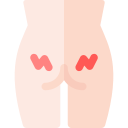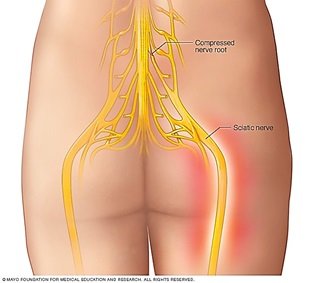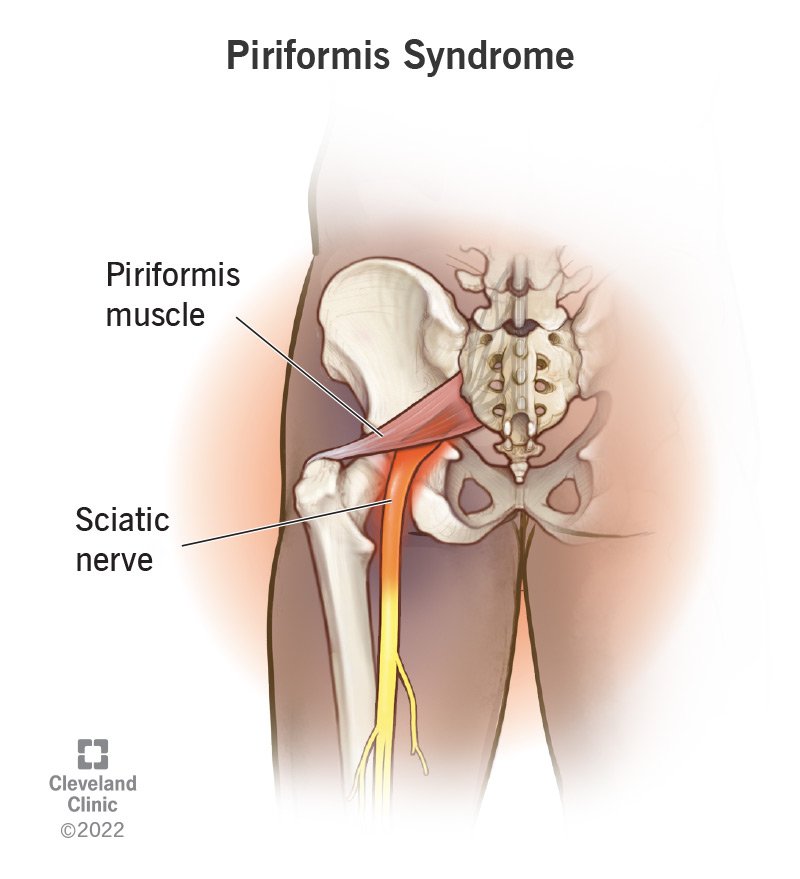
Sciatica Pain
A lumbosacral radicular syndrome (LSR) is characterized by a radiating pain in one or more regions in the lower body;
It may or may not be accompanied by other nerve irritation symptoms and/or symptoms of decreased sensation or muscle power. It is caused by nerve root irritation/inflammation and/or compression.

The terms radicular pain and radiculopathy are also sometimes used interchangeably, although they certainly are not synonyms.
In the case of radicular pain, only radiating pain is present, while in the case of radiculopathy, sensation loss and/or reduction in muscle power can be observed.
What is the most common reason for Sciatica?
In patients under 50 years of age, a herniated disc is the most frequent cause of Sciatica. After the age of 50, radicular pain is often caused by age related degenerative changes in the spine.
How does the Sciatica pain feel and what aggravates/relieves the pain?
The patient may experience the radiating pain as sharp, dull, piercing, throbbing, or burning. Pain caused by a herniated disc classically increases by bending forward, sitting, coughing, or (excessive) stress on the lumbar discs and can be avoided by lying down or sometimes by walking.
Where pain is from a lumbar spinal canal stenosis, it can typically increase when walking and improve immediately upon bending forward.

How is the Sciatica pain clinically diagnosed?
Straight leg raising test is used to diagnose LSR. If radicular pain can be elicited under 60°, there is a large chance that a lumbar herniated disc is present. When L4 nerve root is involved knee reflex is diminished, foot inversion is weak. When L5 is involved, there is decreased ankle dorsiflexion, and weak toe extension, when S1 involvement is present then plantar flexion is decreased.
What are the other causes of Sciatica?
The most common causes are slipped disc and spinal canal stenosis. Other causes include
- Entrapment of the sciatic nerve under a tightened muscle such as Piriformis causing a syndrome called piriformis syndrome. When this tightened muscle gets relaxed the Sciatica gets relieved.
- Spondylolisthesis is a condition that occurs when one vertebral body slips with respect to the adjacent vertebral body causing radicular or mechanical symptoms or pain. It is graded based on the degree of slippage of one vertebral body on the adjacent vertebral body
- Pelvis injury or bone fracture


What imaging is required to diagnose Sciatica?
Medical imaging, primarily magnetic resonance imaging (MRI), can confirm the presence of a herniated disc; this technique is preferred because of the better visualization of soft tissues and the lower radiation dose.
In the event of an unclear clinical picture or in the absence of radiological evidence for radicular complaints, electromyography (EMG)/nerve conduction studies (NCS) can be performed to differentiate lumbar radicular syndrome from peripheral neuropathy.
When is an emergency Surgery indicated? What is Cauda equina syndrome?
Emergency surgery is indicated in cauda equina syndrome, result of a large, central disc herniation with compression of the low lumbar and sacral nerve roots, usually at the L4-L5 level. As a result of involvement of lower nerve roots, a significant bowel and urination dysfunction can arise with a characteristic loss of pain and sensation in the buttock region. If the lumbar nerve roots are also involved, this leads to weakness in the legs that can possibly lead to paraplegia with a neurological loss of function due to a herniated disc, immediate surgical treatment is usually recommended.
How is Sciatica treated?
Medically treated with Non steroidal Anti inflammatory Drugs/Nerve Strengthening medications followed by exercise therapy.

What is the need for Epidural Steroid?
If the pain doesn’t get relieved in 4-6weeks time or if the pain is severe affecting the patients’ quality of life, then Epidural Steroid would be effective in most of these patients.
The logic of epidural corticosteroid administration rests on the anti-inflammatory effect of the corticosteroids, which are administered directly onto the inflamed nerve root. There are three approaches: interlaminar, transforaminal, and caudal.
Transforaminal steroid injection is delivering the steroid to the epidural space nearer to the nerve roots and hence more effective than interlaminar.

When is Caudal Epidural Steroid indicated?
Caudal epidural steroid is indicated when the lower lumbar and/or sacral nerve are affected or when there is spinal canal stenois. Here the steroid in injected in the lower spinal canal which provide effective relief from LSR.
What is selective lumbar nerve root injection?
When disc prolapse compresses a specific nerve root, the steroid can be deposited near that particular nerve root alone under fluoroscopic image guidance.
Does the pain come back after steroid injection?
All steroid injections are followed by a short period of rest and then they should start doing spinal exercises, to strengthen the core muscles, which will help in preventing the pain from coming back.

 +91 8248827895 |
+91 8248827895 |  absolutevitalhealth@gmail.com
absolutevitalhealth@gmail.com
 Joint Pain
Joint Pain